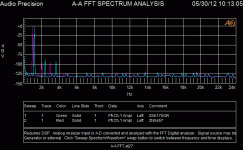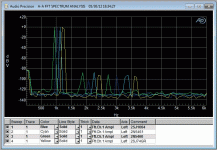Attached are things I have shown before. A distortion comparison of a carbon composition resistor compared to a metal film type of the same value, tolerance and wattage. With a THD measurement they are very close. With an IM measurement at 50Hz and 2 KHz they show differences. That is because the 50Hz is doing more cyclical heating of the resistors.
Thx for the test!
The metal film is in the second graph, right?
Can u measure a vishay z-foil as well?
In LA #1 I show the distortion of various resistors and how I measured them.
I really need to read your article asap. It's on its way together with vol3.
You'll also find nonlinear resistor properties discussed in chapter 7 of Op Amp Applications and in Douglas Self's Small Signal Audio Design. It shouldn't be surprising to find that carbon comp and thick-film types are the least desirable in terms of linearity and excess noise.
Scott,
So this is not a true resistor vs resistor comparison.
Ed, I meant the graphs in post #174. By eyeball they look sort of 20dB worse in both so forget the second tone (IMD) in the first graph you could compute the IM mathematically.
Can we take under advisement Richard's suggestion to use a larger wattage resistor for Rf and Rg and focus the discussion on the headphone amp.
jackinnj -
That would be great if you would allow the pcb to have larger resistors for Rf and Rg. I've preferred the larger Dales when building chip head amps.
That would be great if you would allow the pcb to have larger resistors for Rf and Rg. I've preferred the larger Dales when building chip head amps.
With the MJE200/210 ~115mA, with the 2SB649AC/D669AC ~135mA
If you select the jFEts as i indicated in the article, the output idle will be about 45mA per device. The jFET should be selected for .8mA idss. This puts everything at zero temp coeff.
-RNM
As shown in the article --> put a 1K resistor in series with the source and read 0.8v across it. true-- not exactly Idss. [I still assume someone will read the article to build it right. Silly me]Idss is measured when source and gate are connected to ground.
Richard -- you should get a royalty for every PEAK semiconductor analyzer sold. Mine arrived from the UK this afternoon.
Richard -- you should get a royalty for every PEAK semiconductor analyzer sold. Mine arrived from the UK this afternoon.
Nifty little gadget, isnt it?
The thin film thru hole parts are more linear than the surface mount versions.You'll also find nonlinear resistor properties discussed in chapter 7 of Op Amp Applications and in Douglas Self's Small Signal Audio Design. It shouldn't be surprising to find that carbon comp and thick-film types are the least desirable in terms of linearity and excess noise.
I usually use a much higher wattage resistor in the feedback than would seem necessary to prevent thermal issues but also to reduce the effects associated with its voltage coeffecient.
I parallel my feedback resistors to deal with these issues - also works well. In a power amp I usually use 2 in parallel for the main feedback but on my new amp U used 3 0.6W devices.
There is a lot of discussion on the metla end caps. Are there any plots showing these actually distorting a dignal. I'd be very interested to know.
If you can't find 2N5457
2SK170GR will work, although as RNM points out these large-geometry devices have non-linear capacitance issues. 2SK170GR is available at Mouser, and the devices are DGS, not DSG as the 2N5457.
The prior FFT I posted was 1V out with Z=250R, the one below is Z=33R showing a comparison with the 2SK170GR and 2N5457
2SK170GR will work, although as RNM points out these large-geometry devices have non-linear capacitance issues. 2SK170GR is available at Mouser, and the devices are DGS, not DSG as the 2N5457.
The prior FFT I posted was 1V out with Z=250R, the one below is Z=33R showing a comparison with the 2SK170GR and 2N5457
Attachments
Using worst case load (33 Ohms) shows the 2nd and 3rd harmonics are in the neighborhood of -90 or under .01% that I said in the article you would get if you did not match transistor compliments. But with matching you can get well below -100. Thx for trying various devices for the DIY-er who might not find the ones I used.... however, I bought all transistors over the Internet for 10-15 cents each. It appears the topology is pretty immune to the specific transistor part..... another plus. -RNM
Last edited:
- Home
- Amplifiers
- Headphone Systems
- Marsh headphone amp from Linear Audio

